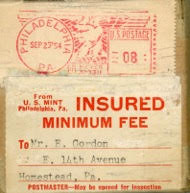
PREV ARTICLE
NEXT ARTICLE
FULL ISSUE
PREV FULL ISSUE
MORE ON PRE-1955 U.S. PROOF SET SHIPPING BOXES
Harvey Stack submitted this interesting (and funny!) response to Bob Rightmire's question about U.S. proof set shipping boxes.
Thanks! -Editor
I remember the period 1950 to 1952 quite clearly as it was in my early days at Stack's and issue of Proof Sets once again. As you know Proof sets were officially made and sold by the U.S. Mint starting in 1858, though there were also earlier strikings of Proof coins (called Specimen Strikings in the earlier days). Proofs were made every year from 1858 to 1915, and also 1916 Cent and Five Cents. (The two most popular series in the earlier 20th Century. It was not until 1936 that they continued the series, when they issued 3837 sets and by 1942 they upped the number 21,120 sets, continued the series to 1950 when they struck 51,386 and slowly advanced to millions of sets today. The bulk of the 1936-1942 sets were sent in cellophane envelopes, with a woven paper outer mailer. In 1950 the Mint introduced boxes and used them until early in 1952, when they started "flat packing the sets" in cellophane sheets and had an number of different containers for distribution for more current years.(from 1936 to 1942 the Mint also made and sold individual Cents and Five Cents in Proof (to satisfy the collectors of those series, but only a few thousand extra of each year were issued) The introduction of boxing in 1950 caused some buyers to reject sets that came directly from the boxes of issue, if they were opened. As each box was about 3 x 3 inches in size, the Mint used packing tape to seal each set. The coins were packed in cellophane envelopes, wrapped in tissue to further protect them in shipment, were sent out in the boxes, and were kept by receivers usually in the sealed box. 1950 and 1951 Proof sets had NO MARKINGS ON THE BOX so one could not be sure what was in the box if still sealed. The BOXED sets of 1952 where STAMPED with the date. and later that year where shipped in manila envelopes, marked with the date, and coins were Flat Packed in celophane within. So the 1950 and 1951 sets, especially to a neophyte were hard to tell WHAT WAS IN THE BOX ? Professional dealers like STACK'S quickly learned that the 1950 sets had a single packing taping around the box. and the 1951 sets had a 2 row crossed taping about the box. So when presented with fresh unopened boxes we knew what we could find inside. However promoters and the advisers who knew less about the coin than containers they came in said, "THE VALUE WAS IN THE SEALED BOX SO DON'T OPEN IT AFTER WE SELL IT TO YOU OR THEY WILL LOSE THEIR VALUE AND ORIGINALITY." SOME ENTERPRISING SELLERS REMOVED THE PROOF SETS FROM THE BOXES, REPLACED THEM WITH MINT STATE COINS, OR SUBSTITUTED "WASHERS", RESEALED THE BOXES, AND WITH THE INSTRUCTIONS "don't open these as the will lose their originality and value", so the buyer bought real proofs or a 'pig in a poke". Well these noted "instructions" caused problems in retail shop as Stack's had. A client would come in and ask for a 1950 or 1951 Proof set and since we had bought a quantity direct from the Mint, we took a box out of a drawer, and proceeded to slice it open so the buyer could see just what he was buying . " don't want one from an open box," he would say, " if you have one sealed I will take it, if not, forget the sale ! " Hearing this I or any of our other salesman would reply, "how do you know what is in the box ? how can you be sure what you are getting ? Maybe there is nothing in the box, or it is filled with sink washers, or just dirty old coins?" The client would shout back, " I read and heard the value was in the sealed box, and if you cannot get one like I asked for, I will leave the store !" So to please the client, who was so uninformed that we took another SEALED BOX out of the draw and gently handed it to so it would not "drop on the counter" and again lose its value because the box could have been dented(?) and made the sale. It proves that a "little knowledge is dangerous" and that you cannot get information solely from what you are told; learn about coins and how they were issued before you make the errors of your way and lose interest in collecting. The story about "DON'T OPEN THE BOX OR IT WILL LOSE ITS VALUE" can probably be repeated today, for some old time collection can still have sealed boxes as a "store of value".
Bob is still looking for images of these pre-1955 U.S. Proof Set shipping boxes. Can anyone help? Thanks. -Editor
To read the earlier E-Sylum article, see:

Wayne Homren, Editor The Numismatic Bibliomania Society is a non-profit organization promoting numismatic literature. See our web site at coinbooks.org. To submit items for publication in The E-Sylum, write to the Editor at this address: whomren@gmail.com To subscribe go to: https://my.binhost.com/lists/listinfo/esylum All Rights Reserved. NBS Home Page Contact the NBS webmaster 
|
